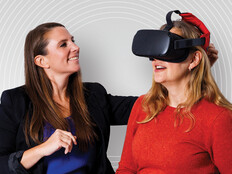Campus Technology 2017: Virtual Reality Is More Than a New Medium
Step inside a Mongolian tent. Experience the daily reality of homelessness. Or immerse yourself inside a surrealist painting by Salvador Dalí.
These are some of the virtual reality experiences that already exist, with many more on the horizon, according to experts who gathered Thursday at the Campus Tech conference in Chicago for “Future Trends Forum Live: Teaching and Learning in a Virtual, Wearable and AI World.”
Bryan Alexander, president of Bryan Alexander Consulting and host of the Future Trends Forum webcast, joined Emory Craig, director of e-learning and instructional technology at the College of New Rochelle, and Maya Georgieva, co-founder and chief innovation officer at Digital Bodies Immersive Learning, for a conversation about VR — where it is now and where it’s going.
SIGN UP: Get more news from the EdTech newsletter in your inbox every two weeks!
VR Hardware Advancements Are Moving Quickly
“It’s actually getting pretty exciting,” Georgieva said, noting that legacy companies and startups alike have projects in the works that will soon be on the market. Look for standalone, wireless VR headsets later this year from Facebook and Google.
Technical improvements that will enrich the quality of immersion are also on the horizon, Craig said. For example, a jump from the current three degrees of tracking up to six degrees will enable headsets to sense not only where a user’s head is, but also locate the user’s body, which will enhance the sense of presence in a VR experience.
Craig said he’s also looking forward to the wireless component, noting that now, users can easily trip over connective cables, which jars them out of the experience. “It breaks the illusion,” he said.
The next evolution, Craig said, will be glasses capable of supporting VR and augmented reality. He predicts they’ll become commonplace, eliminating the need for VR apps on a smartphone.
“I think it’s going to be a universal device,” he said. “Eventually, we’ll end up with some kind of glasses where we can just dial in the level of immersion that we want.”
Huge Potential for VR Content
The big question, Alexander said, is now that the hardware is advancing, where will the content come from?
A number of media publishers, including The New York Times and The Economist, have jumped into VR storytelling, Georgieva said. That fits well with the traditional use of news media in education, she noted, and it’s a good place for educators to look for VR content.
“If there’s a real challenge here now, I think it really is in content development,” Craig said. “The hardware has its challenges, but we haven’t begun to tap into what we can do with the hardware we already have.”
How to Get Started with VR on Campus
For educators who haven’t yet experienced VR, or who lack an established VR presence on campus, Georgieva suggested hosting an event to simply give people the opportunity to try it.
“Create that opportunity on your campus first. Just give people the exposure to this technology,” she said. “Get the conversation started and then look for where the conversation takes you.”
Panelists noted that the Google Cardboard headset is an inexpensive way to experiment, and some companies offer rentals of HTC Vive headsets.
The question of when to use VR is also likely to arise in classrooms as educators figure out how to incorporate this new tool into their teaching.
“Doing VR for the sake of VR makes no sense whatsoever,” Craig said. “Ask when does it make sense to do this in VR? Does a sense of presence help this, or is it better suited to traditional media?”
Early-Stage VR Is a Unique Point in History
VR is so new and so unlike any previous technology that it represents the start of a new era, the panelists said. Georgieva noted that some libraries are already trying to figure out how to preserve early forms of VR content, which could easily disappear as the technology evolves. She likened it to film reels of the early 20th century, now considered valuable relics of history.
The panelists also discussed the change in user habits as they learn to integrate new technologies, like VR, into existing capabilities. “We first copy and paste forms from the old media,” Alexander said. “In the second stage, we ask, what can we do with this uniquely?”
What differentiates VR, Craig said, is that “we cannot think about VR as another form of media. It’s a new media. It’s something different.”
Georgieva agreed: “We are living in the birth of a media. Just understand how thrilling and exciting it is to be a part of it and to get our students to think about it.”
Catch more updates from Campus Technology 2017 on EdTech's official event page.









